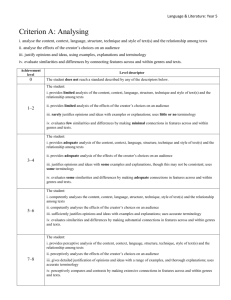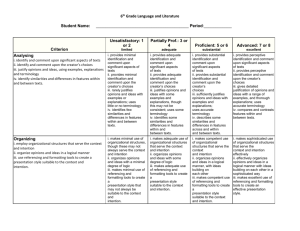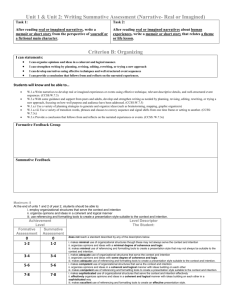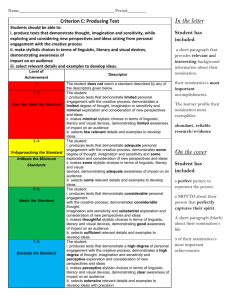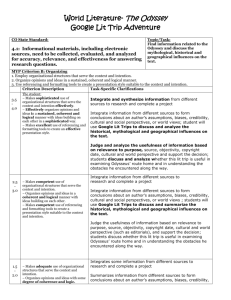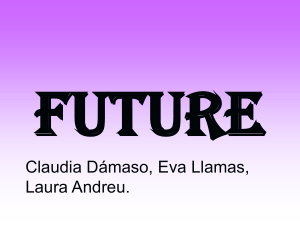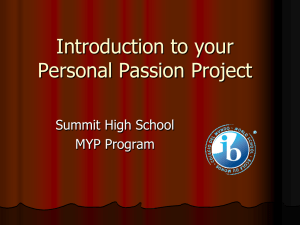File - Ms. Flynn: 6th Grade ELA
advertisement
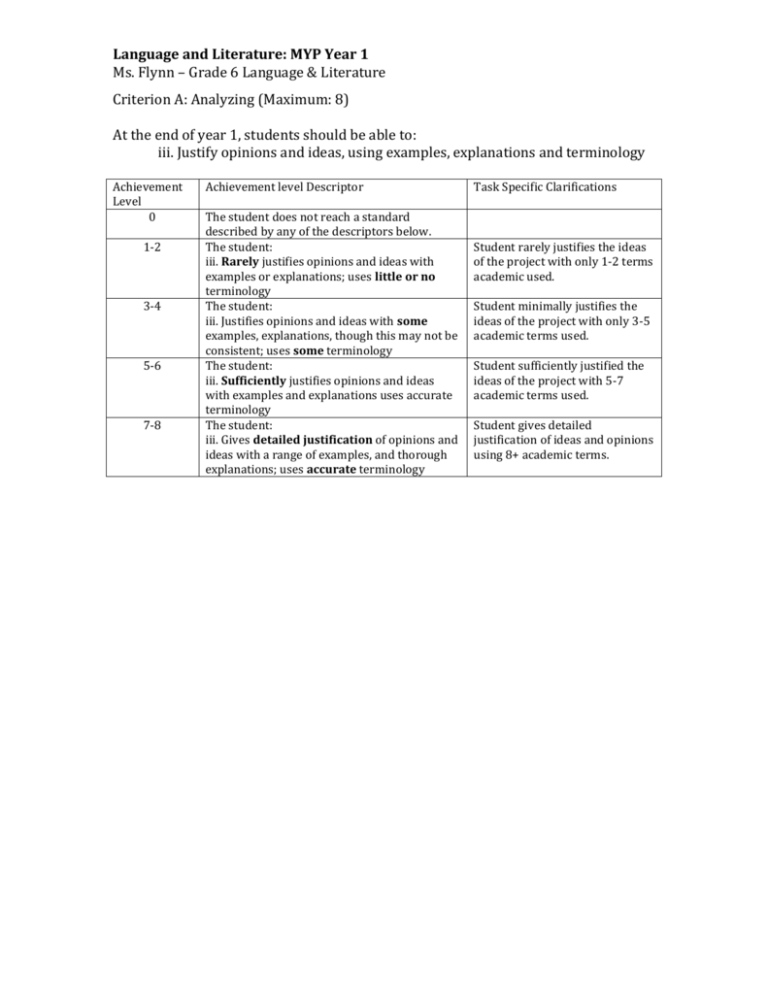
Language and Literature: MYP Year 1 Ms. Flynn – Grade 6 Language & Literature Criterion A: Analyzing (Maximum: 8) At the end of year 1, students should be able to: iii. Justify opinions and ideas, using examples, explanations and terminology Achievement Level 0 1-2 3-4 5-6 7-8 Achievement level Descriptor The student does not reach a standard described by any of the descriptors below. The student: iii. Rarely justifies opinions and ideas with examples or explanations; uses little or no terminology The student: iii. Justifies opinions and ideas with some examples, explanations, though this may not be consistent; uses some terminology The student: iii. Sufficiently justifies opinions and ideas with examples and explanations uses accurate terminology The student: iii. Gives detailed justification of opinions and ideas with a range of examples, and thorough explanations; uses accurate terminology Task Specific Clarifications Student rarely justifies the ideas of the project with only 1-2 terms academic used. Student minimally justifies the ideas of the project with only 3-5 academic terms used. Student sufficiently justified the ideas of the project with 5-7 academic terms used. Student gives detailed justification of ideas and opinions using 8+ academic terms. Language and Literature: MYP Year 1 Ms. Flynn – Grade 6 Language & Literature Criterion B: Organizing (Maximum: 8) At the end of year 1, students should be able to: i. Employ organizational structures that serve the context and intention ii. Organize opinions and ideas in a logical manner iii. Use referencing and formatting tools to create a presentation style suitable to the context and intention. Achievement Level 0 1-2 3-4 5-6 7-8 Achievement level Descriptor The student does not reach a standard described by any of the descriptors below. i. Makes minimal use of organizational structure, though these may not always serve the context and intention. ii. Organizes opinions and ideas with a minimal degree of logic. iii. Makes minimal use of referencing and formatting tools to create a presentation style that may not always be suitable to the context and intention. i. Makes adequate use of organizational structures that serve the context and intention. ii. Organizes opinions and ideas with some degree of logic. iii. Makes adequate use of referencing and formatting tools to create a presentation style suitable to the context and intention. i. Makes competent use of organizational structures that serve the context and intention ii. Organizes opinions and ideas in a logical manner, with ideas building on each other. iii. Makes competent use of referencing and formatting tools to create a presentation style suitable to the context and intention. i. Makes sophisticated use of organizational structures that serve the context and intention effectively. ii. Effectively organizes opinions and ideas in a logical manner with ideas building on each other in a sophisticated way iii. Makes excellent use of referencing and formatting tools to create an effective presentation style. Task Specific Clarifications Presentation lacks a structure. There is minimal logic to the organization of thoughts and minimal referencing of research materials. 1-2 pieces of cited evidence. Presentation has adequate structure. There is a sense to the organization, but there may be off topic additives. There is an adequate amount of referencing of research materials, 3-5 pieces of cited evidence. Presentation has a logical and competent structure. There is a logical sense to the organization. There is referencing of research materials, 6-7 pieces of cited evidence. Presentation has a sophisticated structure. There is an effective organization. There is an excellent amount of relevant referencing of research materials, 8+ pieces of cited evidence. Language and Literature: MYP Year 1 Ms. Flynn – Grade 6 Language & Literature Criterion C: Producing Text (Maximum: 8) At the end of year 1, students should be able to: i. Produce texts that demonstrate thought and imagination while exploring new perspectives and ideas arising from personal engagement with the creative process. ii. Make stylistic choices in terms of linguistic, literary and visual devices, demonstrating awareness of impact on an audience. iii. Select relevant details and examples to support ideas. Achievement Level 0 1-2 3-4 5-6 7-8 Achievement level Descriptor The student does not reach a standard described by any of the descriptors below. i. Produces tests that demonstrate limited personal engagement with the creative process; demonstrates limited degree of thought or imagination and minimal exploration of new perspectives and ideas. ii. Makes minimal stylistic choices in terms of linguistic, literary and visual devices, demonstrating limited awareness of impact on an audience. iii. Selects few relevant details and examples to support ideas. i. Produces tests that demonstrate adequate personal engagement with the creative process; demonstrates some degree of thought or imagination and some exploration of new perspectives and ideas. ii. Makes some stylistic choices in terms of linguistic, literary and visual devices, demonstrating some awareness of impact on an audience. iii. Selects some relevant details and examples to support ideas. i. Produces tests that demonstrate considerable personal engagement with the creative process; demonstrates considerable degree of thought or imagination and substantial exploration of new perspectives and ideas. ii. Makes thoughtful stylistic choices in terms of linguistic, literary and visual devices, demonstrating good awareness of impact on an audience. iii. Selects sufficient relevant details and examples to support ideas. i. Produces tests that demonstrates a high degree of personal engagement with the creative process; demonstrates a high degree of thought or imagination and perceptive exploration of new perspectives and ideas. ii. Makes perceptive stylistic choices in terms of linguistic, literary and visual devices, demonstrating clear awareness of impact on an audience. iii. Selects extensive relevant details and examples to support ideas. Task Specific Clarifications Lack of creativity through ideas that are researched. Very simple word use, sentence structure and vocabulary. 1-3 examples and details to support ideas. Display of adequate creativity through ideas that are researched. Simple word use, sentence structure and vocabulary. 4-5 examples and details to support ideas. Considerable display of creativity through ideas that are researched. Thoughtful word use, sentence structure and vocabulary. 6-7 examples and details to support ideas. Thorough display of creativity through ideas that are researched. Expansive word use, sentence structure and vocabulary. 8+ examples and details to support ideas. Language and Literature: MYP Year 1 Ms. Flynn – Grade 6 Language & Literature Criterion D: Using Language (Maximum: 8) At the end of year 1, students should be able to: i. Use appropriate and varied vocabulary, sentence structures and forms of expression ii. Write and speak in an appropriate register and style iii. Use correct grammar, syntax and punctuation iv. Spell (alphabetic languages), write (character languages) and pronounce with accuracy Achievement Level 0 1-2 3-4 5-6 7-8 Achievement level Descriptor The student does not reach a standard described by any of the descriptors below. i. Uses a limited range of appropriate vocabulary forms of expression. ii. Writes and speaks in an inappropriate register and style that do not serve the context and intention. iii. Uses grammar, syntax and punctuation with limited accuracy; errors often hinder communication. iv. Spells/writes and pronounces with limited accuracy; errors often hinder communication. i. Uses an adequate range of appropriate vocabulary forms of expression. ii. Writes and speaks in an sometimes register and style that serve the context and intention. iii. Uses grammar, syntax and punctuation with some degree of accuracy; errors sometimes hinder communication. iv. Spells/writes and pronounces with some degree of accuracy; errors sometimes hinder communication. i. Uses a varied range of appropriate vocabulary forms of expression competently. ii. Writes and speaks competently in a register and style that serve the context and intention. iii. Uses grammar, syntax and punctuation with a considerable degree of accuracy; errors do not hinder communication. iv. Spells/writes and pronounces with a considerable degree of accuracy; errors do not hinder communication. i. Effectively uses a range of appropriate vocabulary forms of expression. ii. Writes and speaks in a consistently appropriate register and style that serve the context and intention. iii. Uses grammar, syntax and punctuation with a high degree of accuracy; errors are minor and communication is effective. iv. Spells/writes and pronounces with a high degree of accuracy; errors are minor and communication is effective. Task Specific Clarifications Limited vocabulary. The style of writing is not appropriate for the assignment. 10+ grammatical errors. 10+ spelling errors. Adequate vocabulary. The style of writing is appropriate for the assignment, but may stray occasionally. 6-9 grammatical errors. 6-9 spelling errors. Varied vocabulary. The style of writing is appropriate for the assignment. 3-5 grammatical errors. 3-5 spelling errors. Effective vocabulary. The style of writing is appropriate for the assignment and effective for the reader. 0-2 grammatical errors. 0-2 spelling errors. Language and Literature: MYP Year 1 Ms. Flynn – Grade 6 Language & Literature SUMMATIVE ASSESSMENT GRADE BREAKDOWN CRITERION Criterion A: Analyzing iii. Justify opinions and ideas, using examples, explanations and terminology. Criterion B: Organizing i. Employ organizational structures that serve the context and intention. ii. Organize opinions and ideas in a logical manner. iii. Use referencing and formatting tools to create a presentation style suitable to the context and intention. Criterion C: Producing Text i. Produce texts that demonstrate thought and imagination while exploring new perspectives and ideas arising from personal engagement with the creative process. ii. Make stylistic choices in terms of linguistic, literary and visual devices, demonstrating awareness of impact on an audience. iii. Select relevant details and examples to support ideas. Criterion D: Using Language i. Use appropriate and varied vocabulary, sentence structures and forms of expression. ii. Write and speak in an appropriate register and style. iii. Use correct grammar, syntax and punctuation. iv. Spell (alphabetic languages), write (character languages) and pronounce with accuracy IB GRADE EARNED
